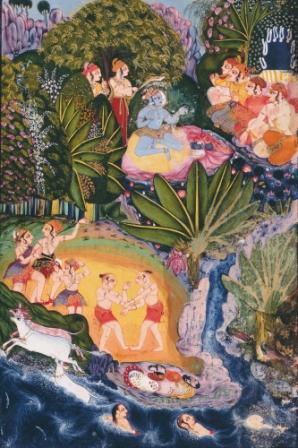Luminous Labels: Krishna in a Garden Labels
We received some great entries for our first label challenge! Here are our favorites. We chose these submissions because they all exemplify techniques that curators use to help audiences engage with works of art.
Our first label challenge was Krishna in a Garden (ca. 1660-1700):
Label 1:
“Krishna In A Garden –AKA “Summer Camp with Krishna”. He maybe blue, but he’s known as a prankster, a teacher and a Supreme Being. It seems “Big K” is telling some campers a riveting legend. Of course, if this was a slasher movie, “Big K” would say, ‘I heard a noise in the woods, I’ll go check it out.'” – Candice
Natasha Says: The author of label one brings in pop-culture references. Curator Barbara Brotherton employed a similar technique in the recent SAM exhibition Behind the Scenes: The Real Story of the Quileute Wolves. Working in collaboration with the Quileute tribe, she used the popularity of the Twilight book series as a springboard to discuss Quileute art and culture.
Label 2:
“Landscape leads the eye through this visually complex image, giving it a sense of narrative. Our eye is drawn first to Krishna, whose blue color sets him apart the other figures. The sky and river emanate from his hand, leading us to the figures below. The cows begin our ascent and the tree line completes the cycle back to Krishna. ” – Dustin Neighly
Natasha says: Label two discusses why the image is visually successful. Sometimes understanding the technical achievements of a work of art can deepen one’s appreciation of the artist’s skill. Curators may highlight visual details, as this writer did, or they might provide additional information about the artist’s medium or tools.
Label 3:
“Chagall meets Rousseau in Lake City, India.” – Gordon Bunting
Natasha says: Label three references the similarities between this work of art and pieces by other artists. Curators draw connections between works of art for many reasons. Sometimes they focus visual similarities between objects, as this author did. Other times they may seek to provide additional context. In the exhibition Painting Seattle: Kamekichi Tokita and Kenjiro Nomura which recently opened at the Seattle Asian Art Museum, guest curator Barbara Johns employs images on several of her labels to make these connections more evident.
Label 4:
“Krishna, believed to the earthly incarnation of Vishnu, a Hindu deity, sits on a lotus blossom teaching his disciples. Water flows around and below the Avatar, representing the Deity in color and purity. Other images within the lush garden, from the devotion to the disciples to the sacred cows at the river depict both holiness and aspects of Krishna’s teachings.” – Terah Baker-Drake
Natasha says: Label four discusses the historical context of the image. Objects in museums are almost always historically significant, but why is not always apparent just by looking at the object itself. Curators often include historic details in their labels such as how the object was used, when and where it was made, and who owned it. Sometimes objects have really exciting histories. In Luminous: The Art of Asia, Curator Catherine Roche tells us a story about some ceramics that were rescued from a shipwreck.
Thanks to everyone who submitted a label! We can’t wait to read what you come up with next week.
– Natasha Lewandrowski, Curatorial and Museum Services Coordinator
